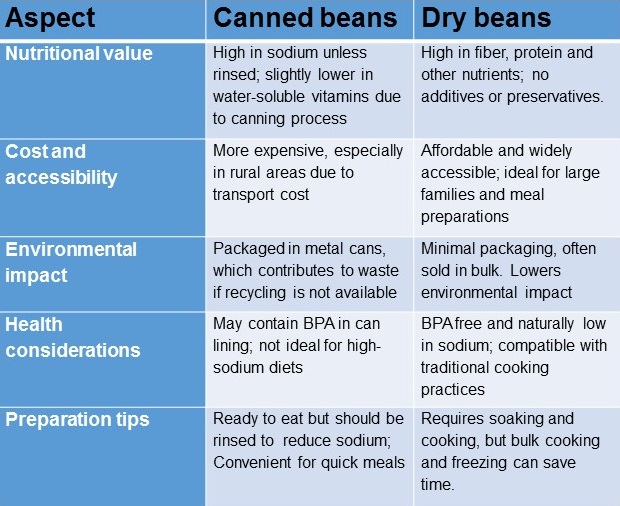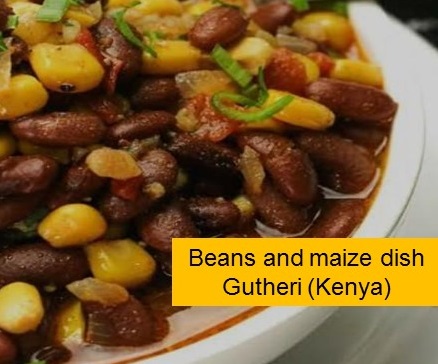By Chiwendu Glory Ogbonna. B.Sc. Biochemistry Freelance writer and DLHA Volunteer. Medically reviewed by the DLHA Team.
Cooked dry vs cooked canned beans.
.jpg) Beans are staple food that hold a special place in African cuisine. Nutritious, affordable, and rich in protein, they play a key role in meals across the continent. From Nigeria’s “ewa riro” (stewed beans) to Kenya’s “githeri” (beans and maize), beans are more than just food, they’re part of the African culture.
Beans are staple food that hold a special place in African cuisine. Nutritious, affordable, and rich in protein, they play a key role in meals across the continent. From Nigeria’s “ewa riro” (stewed beans) to Kenya’s “githeri” (beans and maize), beans are more than just food, they’re part of the African culture.
Dry beans, especially, are valued for their versatility in dishes like bean pudding (moin-moin in Nigeria Yoruba), and bean cakes (akara, in Nigerian Yoruba). These meals aren’t just tasty; they’re part of the African heritage, bringing both flavor and health benefits to the table.
While dry beans have been a trusted option for generation, canned beans are now more accessible across Africa, which raises an important question: Are canned beans as nutritious and flavorful as the traditional dry beans we cook at home? Can they offer the same goodness and fit into the recipes we love?
In this article, we’ll look at canned vs dry beans in terms of nutrition, cost, convenience, and environmental impact. By understanding what each option offers, you’ll be able to choose the one that best suits your health, budget, and family favorites.
Table I summarises the key features between canned vs dry beans. Let’s explore these in details.

Table 1: Comparing features of cooked dry beans vs cooked canned beans. Click on image to enlarge.
Canned beans are prized for their convenience. They are pre-cooked and ready to use, making them a time-saver for busy households. However, they often contain added sodium and preservatives to prolong shelf life. High sodium intake is linked to hypertension, a growing health concern in Africa. Research indicates that rinsing canned beans under water can reduce sodium by up to 40%, but certain nutrients, especially water-soluble vitamins, may be lower due to the canning process.
For those managing blood pressure or concerned about added chemicals, canned beans may not be the best option. Still, rinsing the beans thoroughly can reduce some of the health risks.
Dry beans, on the other hand, offer a more natural alternative. Dry beans, purchased in bulk and cooked at home, offer a more natural option since they typically contain no additives or preservatives. This allows them to retain their full nutritional profile, including fiber, protein, iron, and other key nutrients.
For health-conscious families looking to maintain the nutritional integrity of their meals, dry beans are a superior option. They are also in alignment with traditional African cooking, which emphasizes the use of whole, natural ingredients.
The convenience of canned beans comes at a higher price. In rural areas and smaller markets, canned beans can be significantly more expensive due to transportation and import costs. While canned beans save time, their higher cost may not be practical for households on a tight budget, particularly in parts of Africa where food prices can fluctuate.
Dry beans remain a more affordable option for families across Africa. They are widely available in local markets and provide an economical source of protein. For large families or those preparing meals for the week, dry beans are a cost-effective choice. You can cook them in bulk and freeze leftovers, saving both time and money in the long run.
Canned beans are often packaged in metal cans, which can contribute to landfill waste, especially in regions where recycling programs are limited. In areas with less-developed waste management systems, the environmental impact can be significant. Discarded cans can add to pollution and environmental degradation.
Dry beans are typically sold with minimal packaging often in bulk or simple bags. This reduces waste and the environmental footprint compared to canned beans. Additionally, dry beans require fewer resources for transportation and packaging, making them a more sustainable option. If you looking to minimise environmental impact, dry beans offer a more eco-conscious choice.
While canned beans offer convenience, they sometimes contain added preservatives and BPA (Bisphenol A) in the can lining, which has raised health concerns worldwide. BPA is an industrial chemical linked to various health issues, though BPA-free cans are increasingly available. The added sodium in canned beans is also a concern for those with high blood pressure or other cardiovascular issues, as excessive salt intake can worsen these conditions.
Dry beans naturally fit into African dietary habits, allowing traditional preparation methods that enhance flavor without added chemicals. Cooking beans in clay pots or over open fires, as commonly practiced in many African communities, can add unique taste while retaining nutrients. These methods also allow families to cook beans without preservatives, making dry beans a wholesome, culturally aligned choice.
For those who choose canned beans, rinsing them thoroughly under running water can help lower sodium content. Canned beans are a great quick addition to soups, stews, or salads for busy days.

Dry beans require a bit more preparation but are equally rewarding. Soaking dry beans overnight reduces cooking time, and using a pressure cooker speeds up the process even further. Additionally, cooking dry beans with local spices like garlic, onions, and regional seasonings enhances their flavor and nutritional value, making them perfect for traditional African dishes like Githeri (Kenya bean porridge) or ewa riro (Nigerian beans porridge).
Both canned and dry beans have their place in African diets. For urban families with hectic schedules, canned beans offer convenience if affordable. Just remember to rinse them well to lower sodium levels. However, for those prioritizing nutrition, sustainability, and cost-effectiveness, dry beans are the better option. They are an affordable, eco-friendly choice that fits seamlessly into the rich tradition of African home-cooked meals.
Ultimately, both canned and dry beans provide essential nutrients, and incorporating both into your diet allows you to balance convenience, health, and affordability. Choose the best option based on your family’s needs, and enjoy the many benefits that beans offer to your health and heritage.
1. Harvard T.H. Chan School of Public Health. Legumes and pulses: Types, health benefits, and nutrition [Internet]. Boston (MA): Harvard T.H. Chan School of Public Health; [Cited Nov 20, 2024]. Available from here
2. Mayo Clinic. Nutrition and Healthy Eating. What is BPA, and what are the concerns about BPA? [Internet] 2023 May 15. [Cited Nov11, 2024] Available from here
3. Oceania Can. How Does the Recycling Process of Tinplate Cans Impact the Environment? Oceania Can; [Cited Nov 11, 2024]. Available from here
4. CNN Health. Stock up on this affordable pantry staple for easy-to-make meals [Internet]. 2023 Feb 15 [Cited Nov 20, 2024]. Available from here
5. World Health Organization. Hypertension [Internet]. Geneva: WHO; 2023 [Cited Nov 11, 2024]. Available from here
6. Adebowale Bello. 5 Health benefits of beans Africans need to know. [Internet]. 2024 October 17. [Cited November 19, 2024]. Available from here.
Published: November 20, 2024
© 2024. Datelinehealth Africa Inc. All rights reserved.
Permission is given to copy, use and share content for non-commercial purposes without alteration or modification and subject to source attribution.
DATELINEHEALTH AFRICA INC., is a digital publisher for informational and educational purposes and does not offer personal medical care and advice. If you have a medical problem needing routine or emergency attention, call your doctor or local emergency services immediately, or visit the nearest emergency room or the nearest hospital. You should consult your professional healthcare provider before starting any nutrition, diet, exercise, fitness, medical or wellness program mentioned or referenced in the DatelinehealthAfrica website. Click here for more disclaimer notice.